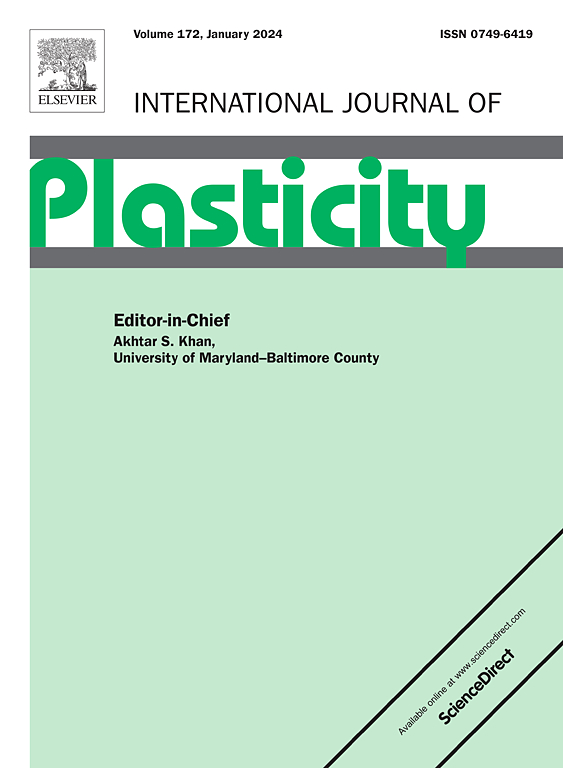Enhancement of mechanical properties in AZ91D magnesium alloy via wire arc additive manufacturing: influence of rapid solidification and solute segregation on microstructure and deformation behavior
IF 12.8
1区 材料科学
Q1 ENGINEERING, MECHANICAL
引用次数: 0
Abstract
The short-process fabrication of high-performance magnesium alloys holds great promise for aerospace and automotive applications, driving advancements in high-end manufacturing. In this study, tungsten inert gas (TIG)-protected wire arc additive manufacturing (WAAM) was employed to produce AZ91D Mg alloy with a weakly textured, equiaxed grain structure. The resulting alloy exhibits an ultimate tensile strength of 284 MPa and uniform elongation of 12.5 %, facilitated by enhanced work hardening. Optimized solidification conditions "freeze" solute atoms in a supersaturated state, inhibiting diffusion and precipitation, and result in a heterogeneous solute distribution. The elevated Al solute concentration suppresses twin propagation, leading to the formation of refined twin lamellae. The ensuing interactions between these fine twins and dislocations play a pivotal role in enhancing the work hardening capability. Additionally, the gradient distribution of Al solute atoms, together with the grain boundary segregation of Al/Zn, effectively weakens the texture, thereby preserving the mechanical isotropy of the WAAM-AZ91D alloy. Additionally, a gradient distribution of solid solution Al atoms extending from grain boundaries to the interior establishes a hardness gradient, effectively alleviating stress concentrations at grain boundaries during deformation and enabling uniform plastic deformation of WAAM-AZ91D. This work expands the application of post-treatment-free short-process fabrication techniques as an effective strategy for the rapid production of high-performance magnesium alloys, broadening their application scope.
电弧增材制造增强AZ91D镁合金力学性能:快速凝固和溶质偏析对组织和变形行为的影响
高性能镁合金的短工艺制造在航空航天和汽车应用中具有很大的前景,推动了高端制造业的进步。本研究采用钨惰性气体(TIG)保护电弧增材制造(WAAM)法制备了弱织构、等轴晶粒组织的AZ91D镁合金。该合金的抗拉强度为284 MPa,均匀伸长率为12.5%。优化的凝固条件将溶质原子“冻结”在过饱和状态,抑制扩散和沉淀,导致溶质分布不均匀。Al溶质浓度的升高抑制了孪晶的扩展,导致孪晶片的细化。这些细小孪晶和位错之间的相互作用对提高加工硬化能力起着关键作用。此外,Al溶质原子的梯度分布和Al/Zn的晶界偏析有效地削弱了织构,从而保持了WAAM-AZ91D合金的力学各向同性。此外,固溶体Al原子从晶界向内部的梯度分布形成了硬度梯度,有效地缓解了变形过程中晶界处的应力集中,使WAAM-AZ91D的塑性变形均匀。本工作拓展了无后处理短工艺制造技术作为快速生产高性能镁合金的有效策略的应用,拓宽了其应用范围。
本文章由计算机程序翻译,如有差异,请以英文原文为准。
求助全文
约1分钟内获得全文
求助全文
来源期刊

International Journal of Plasticity
工程技术-材料科学:综合
CiteScore
15.30
自引率
26.50%
发文量
256
审稿时长
46 days
期刊介绍:
International Journal of Plasticity aims to present original research encompassing all facets of plastic deformation, damage, and fracture behavior in both isotropic and anisotropic solids. This includes exploring the thermodynamics of plasticity and fracture, continuum theory, and macroscopic as well as microscopic phenomena.
Topics of interest span the plastic behavior of single crystals and polycrystalline metals, ceramics, rocks, soils, composites, nanocrystalline and microelectronics materials, shape memory alloys, ferroelectric ceramics, thin films, and polymers. Additionally, the journal covers plasticity aspects of failure and fracture mechanics. Contributions involving significant experimental, numerical, or theoretical advancements that enhance the understanding of the plastic behavior of solids are particularly valued. Papers addressing the modeling of finite nonlinear elastic deformation, bearing similarities to the modeling of plastic deformation, are also welcomed.
 求助内容:
求助内容: 应助结果提醒方式:
应助结果提醒方式:


